How and what to feed cucumbers for their record yield
Do the cucumber beds look pale, the leaves turn yellow, and the fruits are bitter? The most likely reason for these symptoms is a lack of fertilizer. When growing cucumbers in a summer cottage, one must remember that the plant needs regular care. Top dressing will help to get a bountiful harvest.
In this article, we will analyze in detail how to feed cucumbers, we will describe the timing of events. You will find recipes for organic fertilizers that will help grow an environmentally friendly product, learn the timing and methods of feeding, learn how to properly process plants.
The content of the article
What is the best way to feed cucumbers
When growing cucumbers, the question often arises: which fertilizers to use in the greenhouse, and which ones - in the open field? Experts answer this question in detail.
In the greenhouse
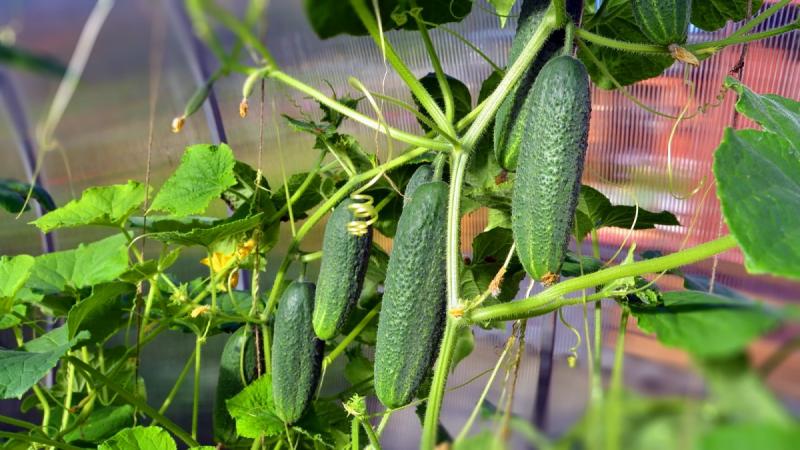
The feeding procedure in the greenhouse is carried out every two weeks 4-6 times a season. The feeding work in the greenhouse can be done at any time, regardless of weather conditions.
Important! When you start feeding cucumbers, it is important to remember that they cannot tolerate excess nutrients.
Terms of top dressing:
- The first time is before planting seeds. Lay compost and humus in the ground for planting.
- The second time is during the growing of seedlings. Fertilize with ammonium nitrate (2 tbsp. L. Nitrate per 8 l of water).
- The third time - a month after planting seedlings in the ground. For this purpose, organic means are used: yeast, herbal infusion, ash. Chemicals are used in the form of a mixture: 2 tbsp. tablespoons of superphosphate, 1 tbsp. a spoonful of ammonium nitrate, a glass of wood ash, a bucket of water. This will help to build up the green mass, and will create more ovaries.
During flowering and fruiting, fertilize every two weeks.
In the open field
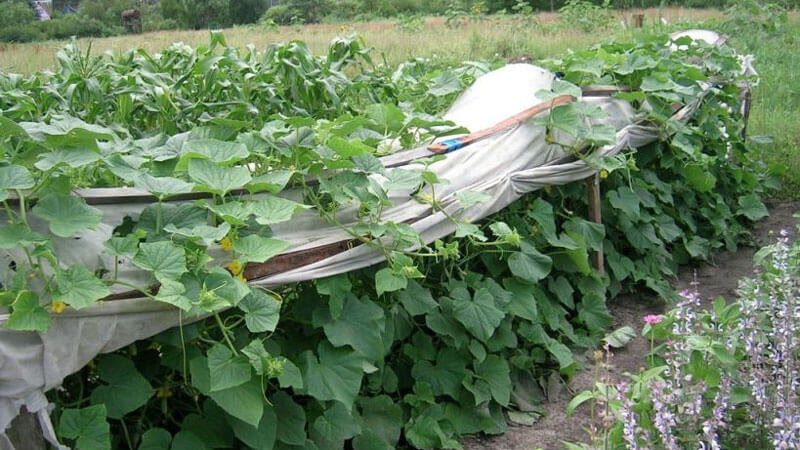
Outdoor cucumbers need more care. Fertilizers are applied 6-8 times per season. In the intervals between root dressings, foliar irrigation is carried out. The product is distributed evenly on the leaves and stem.
Work begins after the second sheet appears. Such nitrogen fertilizers are immediately applied:
- Ammonia is diluted in water in the proportion: 1 tbsp. spoon of alcohol, 8 liters of water. Water with 0.5 liters of solution under the bush.
- After a week, use the brilliant green solution. Add 10 drops of brilliant green to a bucket of water. Spray the stem and leaves from all sides. Top dressing can be done every week before flowering.
- For the regrowth of green mass, yeast tincture is used. Yeast is diluted in warm water, infused for 24 hours and watered at the root. Proportions: 0.5 kg of yeast, 3 l of water, 0.5 l of jam. The resulting mixture is diluted in water (1: 8).
Then they switch to phosphorus-potassium fertilizers. A mixture of superphosphate, urea, ash, tincture of mullein or chicken droppings is used.
The best mineral supplements
During growth, flowering and fruiting, cucumbers need phosphorus, potassium and nitrogen. All these substances are part of mineral fertilizers such as superphosphate, potassium sulfate, ammonium nitrate, urea and others.

Fertilizers are applied from the consumption per square meter:
- nitrogen - up to 10 g;
- phosphorus and potassium - 10-15 g.
For a greater effect, mineral mixtures are used:
- For root feeding, they are prepared according to the recipe: 10 liters of water, 15 g of urea, 50 g of potassium sulfate.
- For foliar fertilization, a mixture is used: 10 l of water, 5 g of ammonium nitrate, 10 g of superphosphate, 8 g of potassium sulfate.
Attention! Superphosphate is dissolved in hot water. Cool the mixture before use.
Organic
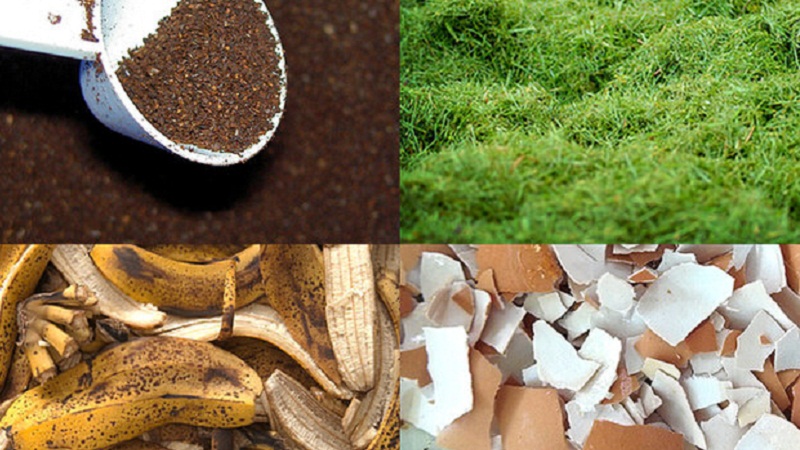
Experienced gardeners prefer organic fertilizing. We offer recipes from simple products that are at hand:
- Onion peel decoction. Brew a glass of raw materials in a bucket of water, leave for 3-4 hours, spray the plants. The tool repels pests and compensates for the lack of nutrients.
- Wood ash suitable for root feeding. The product is useful for acidic soils. It contains a set of trace elements and accumulates nitrogen in the soil. Solution preparation: a glass of ash is diluted in a bucket of water. Water at the root up to six times per season.
- Hay tincture it is prepared as follows: hay is placed in a bucket, poured with water, insisted for 5-7 days. The solution is filtered and the cucumbers are sprayed three times per season at weekly intervals. The product protects cucumbers from powdery mildew.
- Yeast feeding used 2-3 times per season: before flowering, at the beginning of flowering, after the first harvest. The solution is prepared at the rate of: 10-12 g of yeast, 5 liters of warm water, add 0.5 cups of sugar (or 0.5 liters of jam). Everything is mixed and left to ferment in a warm place for 3-5 days. The resulting "chatterbox" is diluted in water in the proportion: 0.5 liters per bucket of water. A liter of solution is poured under the bush. Instead of sugar, put ascorbic acid (2 g per 5 liters of water), yeast can be replaced with a loaf of bread.
- Feeding with iodine stimulates growth, increases productivity, improves the taste of cucumbers, accumulating vitamin C. Using iodine, it is important to observe proportions so as not to harm the plants. Enough 30 drops of iodine in a bucket of water. For root feeding, use a liter of solution under the bush, and spray the tops and leaves (15 drops, 8 liters of water). Processing is carried out every 10 days. Often gardeners combine iodine with milk or serum.
Attention! You cannot use horse manure to fertilize cucumbers, as it contains a large amount of ammonia. When decayed, horse manure releases dangerous nitrates that cause poisoning.
Root and foliar feeding
For full development, cucumbers need nutrition from the roots to the top. Foliar and root feeding will help to solve the problem.
Root feeding is recommended during warm summer. Foliar dressing is used in cold summers when the weather is cloudy and it often rains. At such times, plants do not absorb nutrients well from the soil.
Important. It is better to process plants with a spray bottle.
Selection of fertilizers depending on the growth phase
At each stage of growth and development, cucumbers need certain fertilizers. Improper distribution of nutrition can lead to an increase in green mass and a decrease in fruiting. Plants begin to ache and disappear. The periods of top dressing depend on the stage of growth.
Seedling

To strengthen immunity, seedlings in the greenhouse are fed with nitrogen fertilizers according to the following scheme:
- The first time after the appearance of the second leaf, ammonia diluted in water in a ratio of 1:10 is added. This mixture is poured over a glass under the root.
- The second time is fertilized after two weeks with a mullein diluted in water in a ratio of 1:10.
After landing
Planting in open ground for seedlings is always stressful. A good dose of fertilizer will help the plants adapt to their new location. Top dressing is carried out according to the following scheme:
- Before planting, compost, rotted manure, rotten sawdust are introduced into the beds. If the above materials are not available, use ash and superphosphate. The earth is dug up and moistened.
- If the beds were not fertilized before planting, a week after planting, use the preparations "Universal" or "Aquarin" (a teaspoon per bucket of water). A solution is perfect: a tablespoon of nitrophoska in 8 liters of water.
- After 5-7 days, the beds are watered with a light pink solution of potassium permanganate.
- Two weeks after planting the seedlings, a mullein solution (1:10) is added with the addition of 2 glasses of ash to a bucket of water.
During flowering
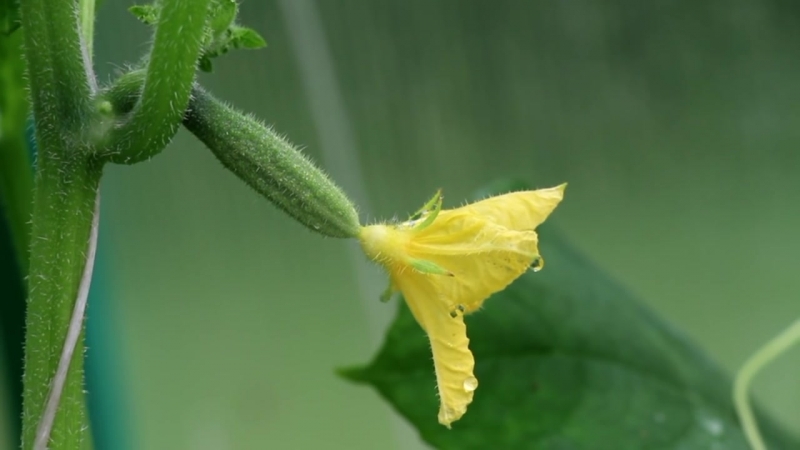
When cucumbers enter the flowering phase, they need phosphorus-potassium nutrition. During this period, the formation of ovaries occurs. To increase them, the following activities are carried out:
- foliar feeding by spraying with a serum solution (1 liter per bucket of water);
- treatment with brilliant green (10 drops per 8 liters of water);
- to attract pollinating insects, honey is added to the solution of brilliant green and serum;
- root feeding with a mixture of superphosphate and potassium phosphate (a teaspoon per 8 liters of water).
During fruiting
After the first harvest, the plants need feeding to recuperate. During this period, it is useful to use organic fertilizers: humus, herb infusion, mullein, ash. Of the mineral fertilizers, potassium nitrate and urea are used. Fertilizers are applied at intervals of two weeks.
Top dressing by month
To help budding gardeners, we have compiled a fertilization schedule by month:
- May June - application of nitrogen fertilizers every two weeks.
- July August September - use phosphorus-potassium supplements.
- In August and September the number of dressings is reduced, increasing the interval between them to three weeks.
How to feed cucumbers to grow well
If you notice that your cucumbers are slowly growing green mass, feed with nitrogen fertilizers.
Fertilizer options:
- Boric acid will make up for the lack of boron. A small bottle of acid is added to a bucket of water. A glass of fertilizer is poured onto the plants.
- Hydrogen peroxide positively affects the growth and development of the bush. It fills the earth with oxygen, delivering nutrition to the roots. Use 2 tbsp per liter of water. tablespoons of peroxide.
- A mixture of superphosphate (40 g), potassium sulfate (10 g), mullein (10 l), 10 l of water. Fertilize at the root in a glass of the mixture.
For a bountiful harvest
How to feed the cucumber beds for a big harvest? The easiest way is to use ready-made growth stimulants "Azogran" and "Agricola".
Fans of folk methods prefer bird droppings with the addition of phosphate and potassium.
So as not to taste bitter
The reasons for the bitterness of cucumbers are different:
- insufficient watering;
- long standing hot weather;
- lack of nitrogen.
Urea will help to saturate the plants with nitrogen. Prepare a solution: 1 tbsp. l. urea, a bucket of water. Three liters are poured onto each plant. Additional solutions bitterness problems - timely watering and darkening the beds with curtains made of corn, branches or fabric.
So that the leaves and ovaries do not turn yellow
If you find that the leaves and ovaries on young bushes are beginning to turn yellow, it is necessary to identify the cause of this phenomenon. This could be due to a lack of nutrients, pests, or improper watering. To find out what trace elements are lacking in cucumbers, the scheme will help:
- Lack of potassium and magnesium - leaves turn yellow at the edges.
- Lack of copper - the upper leaves turn yellow.
- Iron deficiency - leaves turn yellow and green veins appear.
Having identified the problem, you can start fertilizing. We recommend using organic products in such cases:
- herbal tincture with ash;
- kefir diluted with water in a ratio of 1: 5;
- iodine solution with serum (5 drops per 1 liter) in a bucket of water.
Mineral deficiency signals
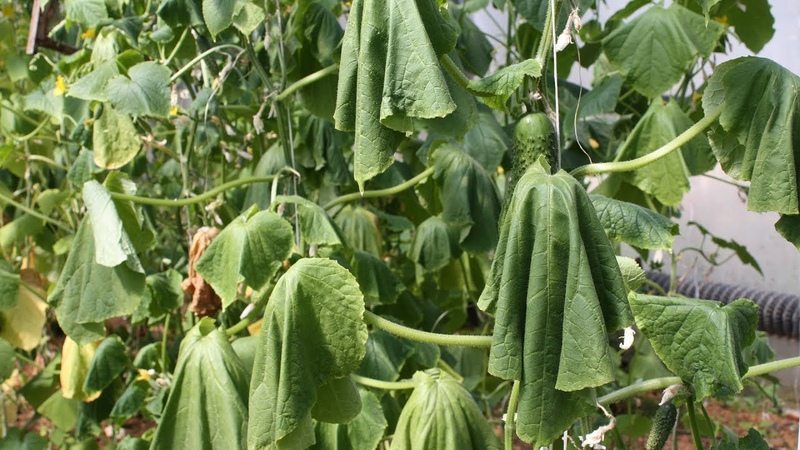
We want to see strong bushes with green leaves and abundant fruits in our garden. But cultivated plants do not always meet our expectations.
How to notice in time that cucumbers lack minerals:
- If the leaves are dark green, bend, the fruits become smaller, then there is an excess of nitrogen in the soil.The solution is to stop fertilizing, watering daily for a week.
- A pale, frail type of plants, thin stems indicate a lack of nitrogen. The green mass grows slowly, the fruits are small, they are few. The solution is to add mullein solution (1:10).
- The dying off of the root system is a sign of excess magnesium. The solution is to increase watering, stop fertilizing.
- The leaves are thin and look burnt. This indicates a lack of magnesium. Solution - feeding with magnesium nitrate (100 g per bucket of water).
- If the leaves darken and curl, then there is not enough calcium. Feed with superphosphate or urea.
- Excess potassium causes a slowdown in the growth of the bush. The leaves turn white, mosaic spots appear.
- Lack of potassium in the initial stage causes the formation of a light border on the leaves. In the future, the leaves darken, the fruits curl and become round. The solution is to use an ash solution (1 glass of ash, 10 liters of water).
- Chlorosis appears on the lower leaves, they darken and fall off. These signs indicate excess copper.
- The lack of copper is manifested in the pallor of the leaves. The shoots wither, the flowers crumble. The solution is to treat the leaves with a 1% solution of copper sulfate.
- The dying off of growth points, shedding of flowers indicate a lack of boron. The solution is to spray with boric acid solution. For this, 2 tbsp. tablespoons of acid are dissolved in 3 liters of hot water and cooled.
When to fertilize
Timely application of fertilizers will help to get a bountiful harvest and keep plants from diseases. Root dressing schemes:
- After the appearance of the second leaf.
- At the beginning of flowering.
- After the first harvest.
- Repeat two more times after two weeks.
Foliar spraying is performed in the intervals between root dressings.
How often to do it
A lack of fertilizer is just as bad for the growth of cucumbers as an excess. It is recommended to carry out top dressing once every 2-3 weeks. Frequent procedures negatively affect the taste of the fruit, accumulating nitrates in them. Particular care is taken with regard to nitrogen fertilizers.
Useful tips from experienced summer residents
Experienced gardeners have something to share. Here are some helpful tips:
- It is advisable to spray plants in the open field in the morning or in the evening.
- Try to use more organic products.
- Observe processing times.
- Stick to proportions in recipes.
- Do root nutrition after abundant watering.
Reviews
Summer residents share their experience in the use of fertilizers in the cultivation of cucumbers.
Elena: «I use organic fertilizers in my garden. I feed cucumbers only with mullein. It contains a complete set of all nutrients. I start processing immediately after the appearance of the sixth sheet. I apply it simultaneously on top of the tops and at the root. "
Vika: “I like to use chemicals. With them there is less hassle and enough for a long time. Cucumbers grow by leaps and bounds. I bring in superphosphate, ash, ammonium nitrate for digging the soil in the spring, when I prepare the beds. During flowering and fruiting, I fertilize with nitrophosphate. "
Read also:
When and what kind of fertilizer to apply in the fall under the garlic.
How and what to feed tomatoes during flowering and setting.
Cucumber "Kolibri" surprising with its yield for pickles and fresh consumption.
Conclusion
It is possible to get a record harvest of cucumbers using foliar and root dressing. The use of substances such as hydrogen peroxide, iodine, whey will help grow an environmentally friendly product. By keeping the interval between treatments 15-20 days, you will maintain the balance of nutrients. Applying nitrogen fertilizers early in the season will help the growth of the bush. Phosphorus-potassium supplements will increase the number of ovaries and fruits.